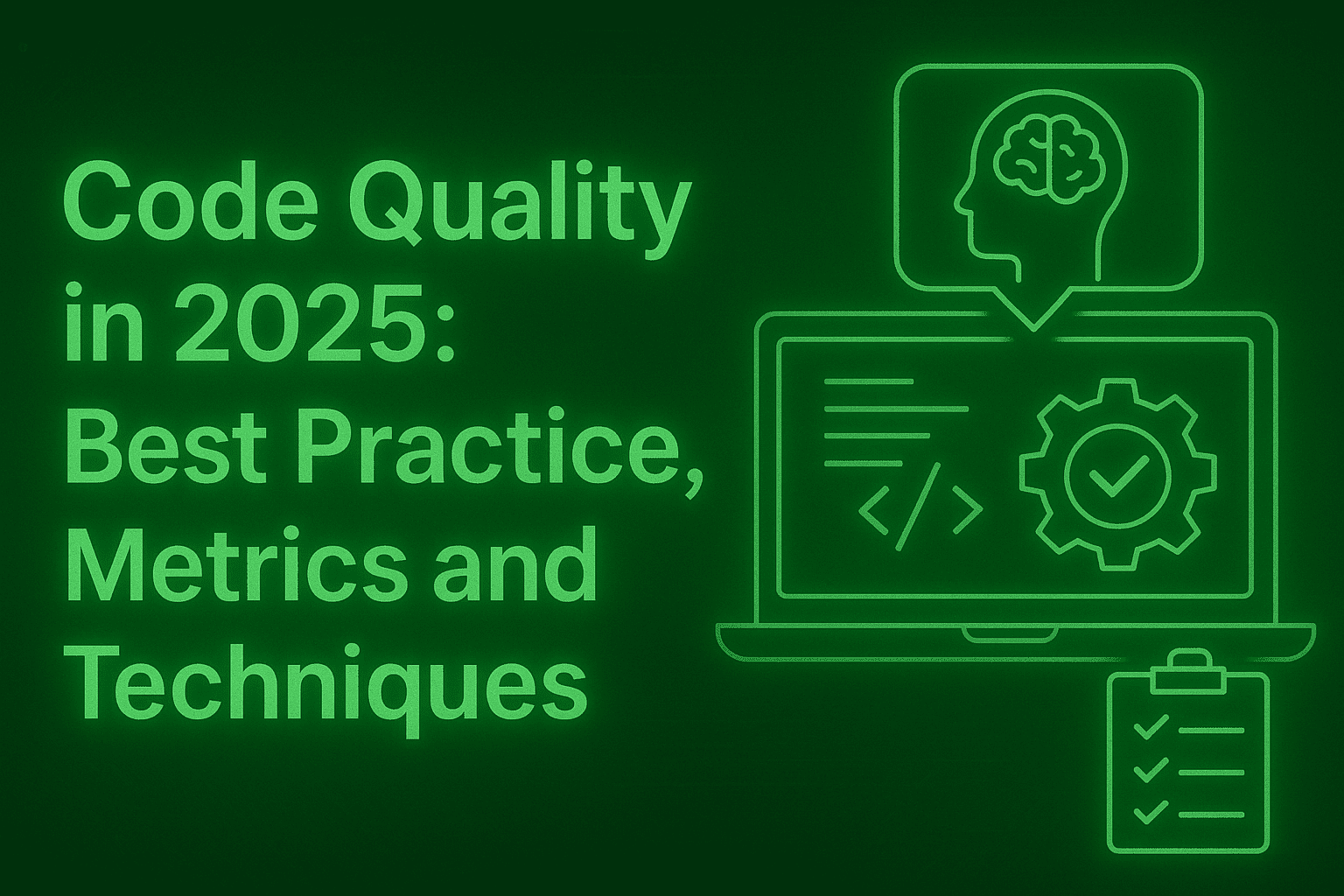In 2025, code quality is no longer defined by how fast code is written, but by how well it integrates into the broader system with architectural integrity, maintainability, and production readiness. With AI copilots generating functional code at unprecedented speed, the real challenge lies in validating that this code is free from hidden flaws such as architectural duplication, race conditions, or compliance gaps—issues that static analysis tools like PMD, ESLint, or SonarQube often miss. These tools catch surface-level issues—unused imports, naming inconsistencies, or indentation errors—but fail to detect deeper risks like duplicated business logic across services or unsafe caching patterns that lead to memory leaks in production. As AI-generated code becomes ubiquitous, the “last mile” of development—the final validation before merge—has become the critical gatekeeper of software reliability, where context-aware review ensures alignment with organizational standards, security policies, and long-term system evolution.
Code Quality as a Continuous Workflow
Code quality in 2025 is a workflow, not a checkpoint. It begins in the IDE or CLI, where intelligent analysis prevents issues before they reach a pull request. Static analysis tools help clear out low-value noise, but they are only the entry point. From there, code review adds domain knowledge and catches logic issues that tools miss. The next stage, architectural alignment, ensures the change fits within the broader system. Inside the PR, reviews become context-aware, enforcing standards and enabling true collaboration around logic and design. After the merge, agentic remediation and learning ensure that any gaps are addressed in production and that those insights feed back into future work.
This shift-left, in-PR, and shift-right approach makes quality a continuous journey rather than a checkpoint. From the first line of code to safe integration in production, every stage contributes to long-term stability and maintainability. For example, on a Java project, PMD flagged indentation issues but missed that a method was duplicating pricing logic already implemented elsewhere. When a bug appeared months later, fixes had to be made in two different services. The real failure wasn’t formatting; it was the lack of architectural awareness.
Why Code Reviews Are the New Gatekeeper
AI-assisted development accelerates coding by generating solutions that often run and pass initial checks. However, the final stage of development, known as the “last mile,” is where subtle flaws can appear. The last mile refers to the portion of code that determines whether changes are fully production-ready. It includes catching issues like race conditions, resource leaks, undocumented assumptions, or minor compliance gaps that automated tests or static analysis might miss.
And the problems come when these issues are compounded as the application scales. More developers are leaning on AI to write code, which means more changes and more pull requests entering the pipeline. Review queues are growing, and with higher volume, the risk of missing important issues increases. Code reviews have become the gatekeeper not just because they catch what tools miss, but because they are the last safeguard in a workflow increasingly driven by AI-generated contributions.
For example, an AI generates a function to process and cache user session data in a high-concurrency environment. The function passes all linting and unit tests, but it uses a naive in-memory cache without eviction policies. In a live system, this can cause memory spikes, inconsistent session states, and subtle race conditions. A context-aware review identifies these risks, flags the unsafe caching strategy, and suggests using the team’s established distributed cache pattern, ensuring reliability under production load.
The AI Development Shift: More Code, More Risk
AI-driven tools have changed how teams write and ship software. Developers can now generate and review code at a pace that was unthinkable a few years ago. But with more code entering production, the risks scale alongside the productivity gains. Even with careful guidance, AI-generated code can introduce unintended behavior if safeguards aren’t in place.
- Replit reported that its AI coding tool produced unexpected outputs during testing, including erroneous data and test results. While no malicious intent was involved, the incident underscores the importance of thorough review, validation, and safeguards when integrating AI-generated code into production systems.
- Amazon’s AI Coding Agent Breach: In July 2025, Amazon’s Q Developer Extension for Visual Studio Code was compromised by a hacker who introduced malicious code designed to wipe data both locally and in the cloud. Although Amazon claimed the code was malformed and non-executable, some researchers reported that it had, in fact, executed without causing damage. This incident raised concerns about the security of AI-powered tools and the need for stringent oversight.
These real-world examples highlight the importance of using AI tools that are deeply integrated with your development context. When AI understands your codebase, dependencies, and team standards, and includes built-in guardrails for security and compliance, it can safely accelerate development.
How Enterprises Should Measure Code Quality in 2025
Code quality has always been tied to metrics, but the way enterprises measure it in 2025 has shifted. Traditional metrics like defect density, test coverage, and churn still play a role, but they are no longer enough when most code is generated or assisted by AI. The challenge is not just correctness at the unit level but whether changes fit the larger system context and remain maintainable over time.
In my experience, an enterprise approach to measuring code quality should combine quantitative indicators with context-aware validation:
Defect Density in Production
Defect density measures the number of confirmed bugs per unit of code (usually per KLOC). It highlights whether a codebase that “looks clean” actually performs reliably in production. A low defect density shows stability and reliability. High density suggests fragile code that slips past reviews and automated checks.
For example, in a financial services backend, defect density exposed recurring transaction rollback failures even though the repo passed static analysis. This gap showed why measuring production outcomes is as important as measuring pre-release checks.
Code Churn and Stability
Code churn is the rate at which code changes over time, often measured as lines added/removed per module. High churn signals instability in design or unclear ownership. Stable modules that rarely change are usually well-designed. If churn is high, it often means technical debt or unclear system boundaries.
Take an example here, an authentication service in a microservices project had ~40% monthly churn. Panto AI flagged it as a hotspot, and we discovered duplicated token validation logic. Consolidating it reduced churn and simplified future changes.
Contextual Review Coverage
Context-aware code coverage measures whether code reviews go beyond syntax/style to catch deeper issues such as architectural misalignment, compliance risks, or missing edge cases. Static analysis won’t catch context-specific violations like ignoring API versioning or bypassing internal frameworks. Reviews ensure the code aligns with the system’s realities.
For example, in a retail API, AI-generated endpoints ignored the team’s versioning strategy. Contextual review caught this before release, preventing downstream client breakages.
Architectural Alignment
Architectural alignment ensures that new code fits within the established system design, patterns, and domain boundaries. It’s not enough for AI-generated code to compile or even pass unit tests; if it bypasses domain rules or reinvents existing components, it introduces hidden risks.
For example, we’ve seen AI suggest custom caching logic that worked locally but ignored the enterprise-standard distributed cache, leading to memory spikes once deployed. These misalignments often go unnoticed in static checks but resurface later as duplicated logic, performance bottlenecks, or fragile integrations.
For enterprises, this balance is especially important in the age of AI-generated code. Copilots can quickly produce functional code, but without guardrails, that code may introduce duplication, security gaps, or performance regressions. Code quality reviews, backed by metrics like test coverage, linting, dependency freshness, and architectural alignment, ensure that AI-generated contributions are production-ready.
Panto AI: Ensuring Production-Ready Code at Scale

Panto AI transforms code quality by embedding intelligent, context-driven review across the entire software development lifecycle. It goes beyond syntax checking to analyze cross-repository dependencies, historical patterns, and architectural fit, catching issues like missing transaction handling in financial systems or misaligned API contracts before they reach production. By integrating directly into GitHub, GitLab, and Bitbucket, Panto AI delivers real-time feedback in pull requests, flags high-risk code with precision, and enables one-click remediation to fix issues instantly.
Its PR Chat feature fosters real-time collaboration, reducing review cycles by 37% while maintaining a high signal-to-noise ratio in feedback. With support for over 30 languages and 30,000+ security checks—including SAST, secret scanning, and IaC analysis—Panto AI ensures that AI-generated code is not only functional but truly production-ready.
In head-to-head comparisons with CodeAnt AI and Greptile, Panto AI consistently outperformed in delivering high-impact feedback. The following table summarizes the comparative analysis:
| Category | Panto AI | Greptile | CodeAnt AI |
|---|---|---|---|
| Critical Bugs | 12 | 12 | 9 |
| Refactoring Suggestions | 14 | 1 | 4 |
| Performance Optimizations | 5 | 0 | 0 |
| False Positives | 4 | 11 | 0 |
| Nitpicks | 3 | 12 | 3 |
| Total Comments | 38 | 37 | 17 |
Panto AI identified 14x more refactoring opportunities and 5x more performance optimizations than Greptile, demonstrating deeper code understanding and actionable insights. While CodeAnt AI achieved zero false positives, it provided only half the number of comments, focusing primarily on basic security scanning rather than comprehensive code review. Crucially, Panto AI maintains a superior signal-to-noise ratio—nearly 60% of Greptile’s comments were either nitpicks or false positives, which erode developer trust and slow down reviews. This depth of insight, combined with actionable remediation, makes Panto AI the most trusted AI code review agent for engineering teams building production-grade software in 2025.
So TL;DR
In 2025, code quality is no longer a technical afterthought but a strategic imperative. With AI generating over 40% of code, speed alone is no longer the measure of progress—production readiness, maintainability, and architectural alignment are. Poor quality leads to costly bugs, security flaws, and technical debt, while high-quality code enables faster iteration, easier onboarding, and long-term scalability. As AI reshapes development, the true differentiator is not how much code is written, but how well it integrates into systems, withstands real-world use, and evolves over time. Ensuring code quality is now the cornerstone of reliable, secure, and sustainable codebases.






